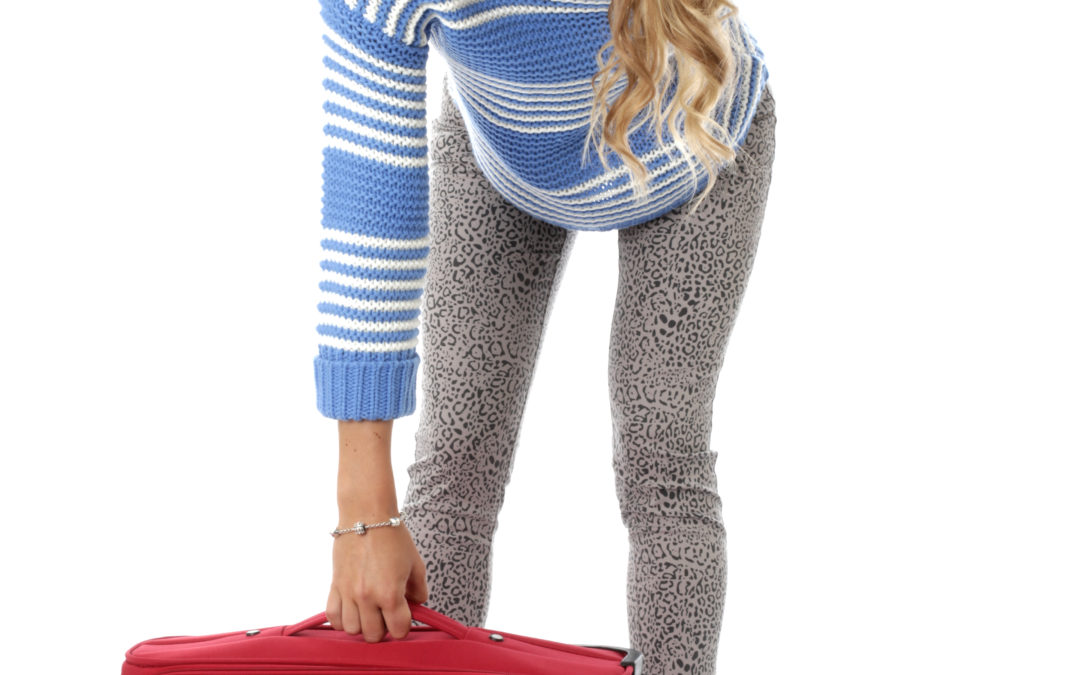How to Avoid Stiffness and Pain with Prolonged Travelling and Sitting
Over the Christmas season our routines change, we do more travelling, more visiting, very likely more sitting and less activity. This change in routine can create challenges for our muscles and joints and result in pain. The type of pain we are talking about is an ache, or feeling of stiffness, or cramping usually across the low back, in one side of the low back, or one buttock. Or into the neck and between the shoulder blades Pain that is sharper, or throbbing, or radiating down the leg or arm is likely not going to respond to the following suggesting, and may actually get worse, so start slowly with these exercises, and stop if your pain increases.
With the holidays, many people are travelling. This can involve prolonged sitting either in planes/airports/cars/trains. Try and get up and walk every 2-4 hours minimum. Also make changes to your sitting posture. I suggest bringing a bath towel in the car-it can be folded up and put between the seat and your back, it can be moved up and down, depending what level of your back is starting to ache. And if your back isn’t bothering you but your shoulders and neck are, try folding up that towel and putting it between your elbow and console beside you-our arms and neck need support too. If you are driving long distances, it is common to relax your driving leg-letting the knee drop out, or shifting/leaning to one side. This can sometimes cause cramping into the buttocks on either side-think about trying to sit evenly on your sit bones,, so you aren’t leaning to one side, changing the weight through those buttocks.
If you are flying long distances, and might fall asleep during the flight, it’s a good idea to use a pillow/scarf/coat to support your neck so as you lean your head to the side, it doesn’t tip too far when you are sleeping, and you wake with spasm in those neck muscles. If you use a neck pillow on the plane, but struggle because it pushes your head forward ( they are quite big), think about turning it around so the opening in the horseshoe shape is at the back of your neck, and you don’t feel pushed forward. This also supports your chin if you end up with your head falling forward as you sleep. Your head will fall back into the chair headrest if your head falls backwards.
Wherever you are going, if you are sitting a long time to get there, your tissues in your low back get used to being on stretch in sitting. Our tissues all have some elastic type fibres in them, and they are good for springing us back into normal positions. But when they have been on stretch for a long time, they lose their ability to quickly spring back into shape. So to protect these tissues from injury, it’s a good idea to spend 10 minutes in standing or walking before you doing any heavy lifting( for example pulling a suitcase out of the trunk of your car, or off the luggage carousel. As well, think about engaging your lower abdominal muscles, and buttocks as well, to use bigger muscle groups, instead of your smaller spinal muscles.
Be aware of your neck posture. Avoid looking down to read, or text. Try and bring the book or device more toward shoulder height. If you are on a plane, you could possibly rest your elbows on your tray, or put the book or device on the tray instead of your lap to raise it.
When you are visiting relatives, and you are spending time on an unfamiliar couch, your back may get stiff. Try and put a small cushion, between the couch and your low back, again for support.
One of the best things to do to help with back discomfort and stiffness is to go for a walk. Make sure you are going at your pace, that your stride feels a comfortable length and pace. Some standing calf stretches will help your legs feel looser.
- Do this by putting one foot behind you, with your toes pointed straight ahead. Keep your back heel on the ground lunge forward, until you feel a pull in the back calf.
- If you haven’t had a hip replacement, you could also sit and cross your legs at the knees, bringing the knee across to the other shoulder. You should feel a gentle pull in your buttock muscle.
- You could also put one ankle on the other thigh just above the knee. Without being aggressive, slightly bend your trunk forward at the hips ( don’t round your shoulders forward). You could feel this in both the buttock or the low back.
- For your neck, gently drop your ear towards one shoulder. Come back to centre-turn your head slightly, so you are looking down towards one foot, then lower your head forward. Do that on both sides.
Be Gentle! These are meant to be comfortable stretches.
I hope these suggestions help make your holidays the most comfortable yet. If you find you are having pain after your travels, please call and make an appointment with one of our physiotherapists. You will benefit from their expertise, and they can help you get back to your normal routine.
The team at Pursuit Physiotherapy would like to take this opportunity to wish you a Merry Christmas, and hope it is filled with time spent with friends and family. We wish you all the best health, and happiness for 2018.
Posted by Leanne Schlachter

